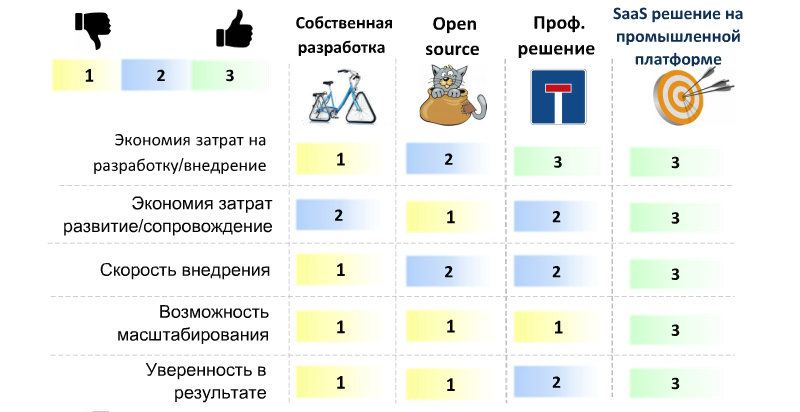Approaches to choosing Service Desk: self-written, free, specialized or professional ?!
The issue of automation of technical support is facing any company with a staff of more than 100 people. User appeals are becoming too numerous to not be registered in any way. After the task of fixing the requests of external clients or internal users is solved, ideas of a service-oriented approach, SLA control (service delivery parameters), asset management, resource planning, accounting for labor costs, managing contractors, increasing loyalty, etc. appear. Another reason for automation is, of course, the simplicity of ensuring the scalable growth of the organization, for example, by the number of external contracts or supported employees.

Interviewing more than 400 customers, Forrester analysts foundthat an average of 30% are dissatisfied with the ITSM solutions that are used in their company. Moreover, among those who use SaaS-solutions dissatisfied only 12%.
We like such statistics, but we cannot be completely objective in this matter. A year ago, we introduced our cloud-based Service Desk ITSM365 solution , created on the basis of the Naumen Service Desk industrial platform. On the other hand, our team has been engaged in ITSM solutions for more than 10 years, which allows us to highlight the advantages and disadvantages of various classes of such solutions. We offer the vision of the ITSM365 team at Service Desk solutions, their categorization and comparison criteria applicable to companies with small IT services (up to 25 IT specialists). In large companies, the criteria and categories will differ significantly.

1 - poor / not optimal, 2 - medium, 3 - good / optimal
In developing the categories, we deliberately avoided trying to group solutions:
In companies with a staff of IT professionals from 7 to 25 people, the tasks and maturity level of IT services are approximately the same. Companies with fewer IT professionals practically do not use IT automation tools.
As a result, having studied the Service Desk market for SMB, we received the following categorization:

In a large company, choosing a solution can be a very difficult task. When comparing offers from different vendors, hundreds of different criteria can be taken into account. If the company does not have the opportunity to allocate a team of IT specialists for this task, then some simple and transparent set of criteria is required. A good example of such criteria is given by the SMART method for setting goals, where
Based on that technique, we offer a similar set of criteria for comparing ITSM solutions. Once again, we recall that these criteria are remote from the consideration of functionality:
These two criteria give us the capital and operational costs of the project, so there is no separate criterion “Cost” among those considered. This is our main M (measurable) measurable criterion.

If you do not agree with the categorization or think that we have missed some criteria, then unsubscribe in the comments!

Interviewing more than 400 customers, Forrester analysts foundthat an average of 30% are dissatisfied with the ITSM solutions that are used in their company. Moreover, among those who use SaaS-solutions dissatisfied only 12%.
We like such statistics, but we cannot be completely objective in this matter. A year ago, we introduced our cloud-based Service Desk ITSM365 solution , created on the basis of the Naumen Service Desk industrial platform. On the other hand, our team has been engaged in ITSM solutions for more than 10 years, which allows us to highlight the advantages and disadvantages of various classes of such solutions. We offer the vision of the ITSM365 team at Service Desk solutions, their categorization and comparison criteria applicable to companies with small IT services (up to 25 IT specialists). In large companies, the criteria and categories will differ significantly.
Compare different categories of ITSM solutions

1 - poor / not optimal, 2 - medium, 3 - good / optimal
Categorization of ITSM Solutions
In developing the categories, we deliberately avoided trying to group solutions:
- in functionality, as rather fine lines are obtained here, and there are too many places for disputes and discussions that move away from the essence of comparison
- targeting the end customer. Here it’s possible to single out only solutions oriented to the work of external support services and to the internal IT service.
- By the number of users or IT professionals, which is generally pointless for small and medium-sized companies.
In companies with a staff of IT professionals from 7 to 25 people, the tasks and maturity level of IT services are approximately the same. Companies with fewer IT professionals practically do not use IT automation tools.
As a result, having studied the Service Desk market for SMB, we received the following categorization:
- Self-written solutions . The idea of doing everything independently and “ideally” is still being visited by the management of companies and IT services. In large companies, this approach may even be justified for truly unique processes. IT automation based on ITIL / ITSM practices is not a unique process. Moreover, these best practices are already embedded in automation tools and their application increases the maturity level of IT services. If a small company "on the knee" is trying to automate existing processes, then no improvement from this comes from practice, unless, of course, there are tasks of a completely basic level of automation. In addition, in such projects there are great risks of dependence on specific performers who usually do not leave any documentation or source codes of the invented bicycle.
- Open source service desk. This is a large class of solutions, and some of them arose precisely as self-written solutions for specific companies. A very attractive side of Open Source solutions is that the products themselves are free. However, in many cases it is necessary to pay for it due to the complexity of implementation, the need to attract consultants who are familiar with the product, lack of support or localization. A problem that is often forgotten when considering and choosing these solutions is that a large number of such products developed on bare enthusiasm “die” when this enthusiasm is exhausted. In addition, the developers of such solutions often do not optimize the code for work with a serious scale of automation and a large number of users. All this will certainly affect in 3-4 years or earlier. It all depends on the growth rate of your business.
- Specialized solutions. We included all commercial Help Desk / Service Desk / ITSM solutions for small and medium-sized businesses in this category. Small business solutions usually cover a small number of ITIL processes, but on the other hand, automation of the broadest range of tasks of a small IT service is usually built into such products.
- Professional solutions developed on an industrial platform . Corporate solutions created for large businesses that are adapted for the small and medium business segment. Such products offer automation of a large number of ITSM processes and the ability to scale as the company grows. There are no risks of exhausting the enthusiasm of the developers, but there are a large number of references from platform users. One of the main ways to make an expensive enterprise platform affordable for small businesses is to provide access to the platform using the SaaS model. With this approach, the need to purchase expensive licenses immediately disappears. Our ITSM365 solution belongs to this category, as it is based on the Naumen Service Desk platform.

Criteria for Comparing ITSM Solutions for Small Businesses
In a large company, choosing a solution can be a very difficult task. When comparing offers from different vendors, hundreds of different criteria can be taken into account. If the company does not have the opportunity to allocate a team of IT specialists for this task, then some simple and transparent set of criteria is required. A good example of such criteria is given by the SMART method for setting goals, where
- S (specific) - specific;
- M (measurable) measurable;
- A (attainable) achievable;
- R (relevant) significant;
- T (time-bounded) correlated with a specific term.
Based on that technique, we offer a similar set of criteria for comparing ITSM solutions. Once again, we recall that these criteria are remote from the consideration of functionality:
- Compliance ITIL . In ITIL collected experience of the best practices of various companies. Yes, for small businesses, many ITIL processes are redundant and there is no need to automate them. ITIL, on the other hand, is the de facto standard for IT service management. Today, any IT service, regardless of whether its management and employees are aware of it, is built on the principles of a service approach. So, if, as a result of Service Desk automation, we want to improve the quality of work with user calls to the IT service, we must immediately focus on the best examples of IT organization. In this case, this is our specific criterion that defines the main objective of the project.
- Total development and implementation costs in the range of 2-3 years . Each time we want to invent a bicycle, it is necessary to compare its quantitative and qualitative indicators with what is already on the market. In small companies, they often forget that people also cost money and for several years the cost of an employee who works on a project more than exceeds the cost of almost any automation tool. At the same time, finding and replacing an employee is a much more difficult task than choosing or abandoning a product.
- Development / maintenance costs. ITSM solutions cannot be implemented once - changes, mastering of new processes, increasing the level of maturity of IT services, business growth and new tasks for its development - all this is laid down in the very principle of building the ITIL approach. The technical support of the solution, the introduction of new functionality and the deployment of updates should also be included in the same category of costs. When analyzing development and maintenance costs, it is important to consider both infrastructure costs and staff training costs.
These two criteria give us the capital and operational costs of the project, so there is no separate criterion “Cost” among those considered. This is our main M (measurable) measurable criterion.
- Confidence in the result. Under this criterion we combined all kinds of risks of the final result. How likely is a successful completion of an implementation project? In any new development, there is always a chance of failure, if you are trying to independently deal with an unfamiliar product built according to a new methodology for you, then the probability of failure is also quite high. On average, every sixth IT project fails . On the other hand, if the solution is tested, tested and used by other companies in your industry and the vendor support team is on your side, then the chances of success are significantly increased. This criterion determines the attainability A (attainable) of the final result.
- The ability to scale. At the stage of choosing Service Desk, and any other solution, many SMB companies do not think about the prospect of 2-3 years. At the same time, successful small businesses are companies that grow very quickly. When choosing a solution, the question arises of how ready it is for higher loads. How the product will behave, and how much it will cost if the number of users and the number of registered requests grow several times or even several orders of magnitude. The load change may be due to both the growth of the organization itself and the desire to use software “to the fullest”, for example, by automating the work of service divisions not related to IT using the Service Desk. The same criterion includes the possibility of expanding the functionality of the solution to automate a wider range of tasks. This is our version of the significant criterion R (relevant) - how long the implemented solution will remain relevant for the company, whether it happens that it will need to be replaced before the start of commercial operation.
- Speed of implementation. This criterion is perhaps one of the key when choosing solutions for small businesses and, especially, for service companies for which Service Desk solution is business critical. Speed of implementation - the time from the moment of signing the contract / payment to the start of work in the solution within the framework of the processes of interest. Note that the speed of implementation and fast results (Fast Win) are an important factor for a new IT director or manager who needs to show his achievements by a certain date, for example, by the end of the year. In our interpretation of SMART criteria, this is the T (time-bounded) time factor.

How we evaluated different ITSM solutions for small businesses
- Self-written solutions . We are skeptical about the possibilities of developing a full-fledged Service Desk solution with the help of employees of a small company. Yes, the task of automating the registration of tickets does not seem difficult, but already at the stage of transition from registering tickets to incident management, in our experience, problems begin. Moreover, one cannot be sure that employees will be able to implement all their plans in a timely manner. As a result, the company, instead of the cost of purchasing ready-made software, pays employees who are engaged in development - the longer the project lasts, the more expensive the final product.
- Open Source Service Desk . All the savings on licenses in such solutions turns into costs for the introduction and maintenance of the product. In order to implement and maintain any Open Source solution, you in the company staff will need a specialist for this solution. Most likely, you will not be able to attract such a specialist from the outside for a permanent job, so it remains either to turn to consultants or to educate and train yourself. Both options range between long or expensive. On the other hand, ITIL processes in such products are implemented in accordance with ITIL best practices, so if everything worked for you, then it worked correctly. Note that among the dozens of customers who have chosen ITSM365 most migrated from Open Source and proprietary solutions.
- Specialized solutions. In this category, good products with a reasonable price for small and medium-sized businesses. If you calculate the costs of licenses and implementation, it is likely that such a solution will cost you less than an Open Source product. By the time you move on to the full use of a professional product, a written solution at best can show an alpha version or the first prototypes. The most difficult stage in such projects is implementation, the results of which completely depend on the team of consultants who carry out it.
- Professional solutions developed on an industrial platform . We took our ITSM365 product here.and the grades given are due to objective reasons. The fact is that for vendors producing such products, each individual implementation is too small compared to the introduction of the main product of the company to spend on it the efforts of consultants of the company. Hence the conclusion - the introduction of such a product should be simplified and accelerated as much as possible by offering ready-made templates, an understandable sequence of steps, tips and other tools to facilitate the project. As a result, in ITSM365 the first application can be registered in a few minutes after gaining access. In addition, ITSM365, like other SaaS products, generally has no capital outlay. You pay for the solution only as long as you use it and to the extent that you need it. And finally, ITIL processes in ITSM365 at the same level as the main Naumen Service Desk platform.
If you do not agree with the categorization or think that we have missed some criteria, then unsubscribe in the comments!
